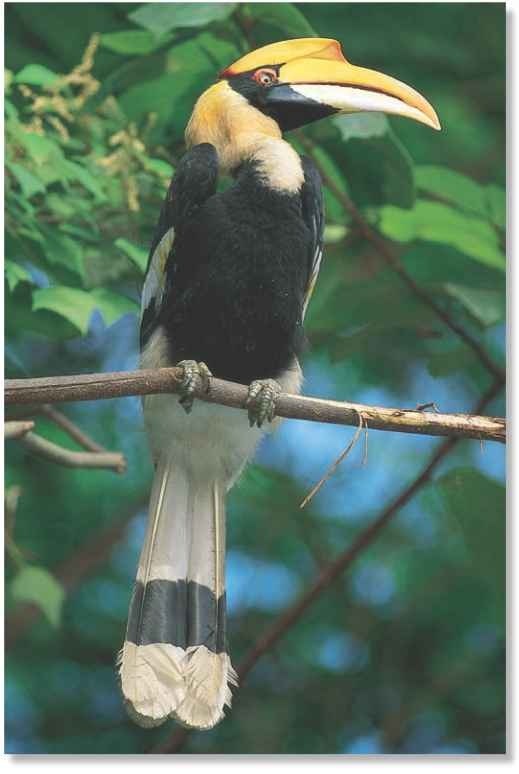ORDER
Coraciiformes
FAMILY
Bucerotidae
GENUS & SPECIES
KEY FEATURES
• Very long bills are topped with a rectangular casque that extends over the head like a hat
• Prefers figs to all other foods, using its huge bill to husk a variety of fruits
• During the breeding season, the female may seal herself behind a wall she has built at the entrance of the nest
WHERE IN THE WORLD?
Found in India, southwestern China, Bangladesh, western Thailand, mainland Southeast Asia, including Laos and > Cambodia, the Malaysia Peninsula and Sumatra

Lifecycle
Despite its strong preference for figs, the omnivorous great Indian hornbill is an accomplished hunter, using its enormous bill to batter prey.
Habitat
Found mostly in India, as its name implies, the great Indian hornbill lives primarily in evergreen and moist deciduous forests, mainly on the lowland plains; it also can be found along the Himalayan foothills and in northern Thailand, extending up to elevations of 6,500′. The hornbill is rare in the Yunnan province in China, but fairly common throughout South Vietnam. An isolated population of great Indian hornbills inhabits West Ghats along the peninsula, from Kolaba to Tenmalai, and the area along the base of the Himalayas from Utta Pradesh to Assam. The great Indian hornbill regularly uses communal roosts in the forests, perching in the topmost branches, with 3-4 birds per tree.
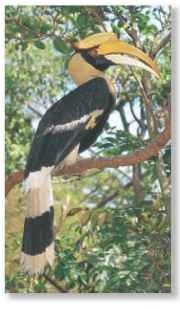
A Prominent profile The hornbill’s striking pied plumage and large, heavy bill are very conspicuous as it perches in its forest home.
Conservation
The great Indian hornbill, also known as the great pied hornbill, is on Appendix II of CITES and listed as vulnerable because of decreasing populations. The decline can be attributed to clearing of forests, which eliminates the birds’ nesting sites and foraging grounds. In addition, hornbills have been hunted for many years in India and Indonesia for both food and as an ingredient in local medicines and rituals. Unfortunately, nesting coincides with the honey-gathering season, and the hornbill’s nesting cavities are discovered along with the bees’ honey in the large trees.
Kadar tribesmen believe the hornbill chick’s blood comforts the soul of the deceased.
The largest known Indian hornbill casque measured 7.5″ long, 4.1″ wide and 2.1″ high.
Breeding
During the breeding season, monogamous hornbills form pairs and return to breeding territories, braying loudly near fruiting trees. Males fight in the air; casque to casque, in order to protect their territories. Courtship rituals, which occur in special breeding areas called leks, include branch-banging and hanging upside down. In addition, the male feeds the female fruit for up to five months before mating, and also will regurgitate fruit into the empty nest, which is usually built in the hollow of a tree. The pair seals off the entrance with droppings, chewed pieces of wood and debris; the female works from inside, the male from outside. The female incubates the 1-3 white eggs for 38-40 days, after which time the female and chicks break down the sealed nest by pecking repeatedly in order to receive food from the male. The parents feed the hatchlings for up to five months by regurgitation; the parent’s gullet may be distended with up to 50 grape-sized fruits. Juveniles join parents in flight upon emerging from the nest.
King and Queen
The male’s “crown” (left) differs from the female’s.
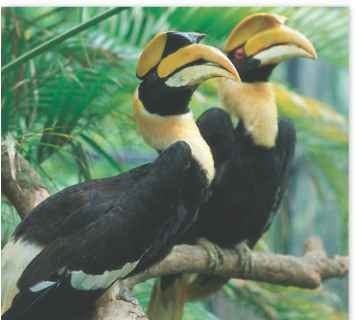
Food & feeding
Though the hornbill has a strong preference for figs, the bird also hunts insects, lizards, snakes and nestlings. When it comes to eating, the hornbill is adaptable, employing various feeding methods including picking food up, digging into rotting wood, swooping down from a perch or plucking an item from foliage while in flight. Groups of up to 20 hornbills often make treks after fruit.The bird covers large areas daily by air, targeting fruit trees often within bamboo forests. The great Indian hornbill batters larger prey against tree branches to kill the victim, and softens it up using its bill to crush the dead animal if it is too large to swallow.
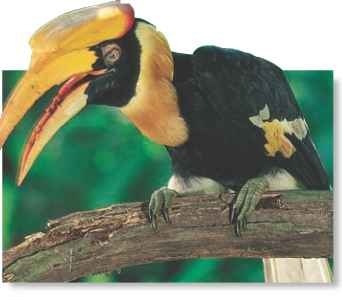
Behavior
The great Indian hornbill is a social bird. It travels in pairs, small family groups or flocks of up to 40 during monsoon season. This noisy bird’s calls range from low guttural sounds to a loud, reverberating kok that may be repeated at regular intervals. Nestlings make feeble croaking sounds, alternating with whistling noises, while older chicks utter harsh churrs, gradually working up to guttural squeals when handled.The bird also growls loudly when defending the nest from intruders in the trees.
The great Indian hornbill flies with 3-4 quick deep flaps, followed by a long glide through the airThis tree-dwelling bird travels between branches by hopping sideways; the hornbill rests in what appears to be a “kneeling” position.
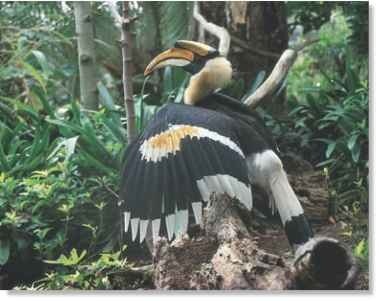
Drying off A hornbill sunbathes after bathing in wet foliage.
a mixed bag

Food show…
An abundant supply of figs sates the hearty appetites of a flock of hornbills. A douc langur takes in the show from above.

Stay away…
A hornbill, through its posture and threatening approach, warns the monkey to stay away from its figs. The langur quickly complies.
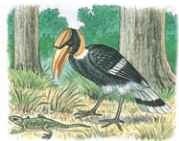
Quick ambush…
The hornbill eyes a large oriental long-tailed lizard walking along the ground and prepares to pounce on its unlucky prey.
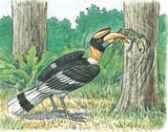
Meal preparation
The bird grabs the lizard and pounds it against a tree, which softens the flesh, making it easier to swallow.
Profile
Great Indian Hornbill
After bathing, the great Indian hornbill perches and extends its wings for hours, until it dries off and regains its body heat.
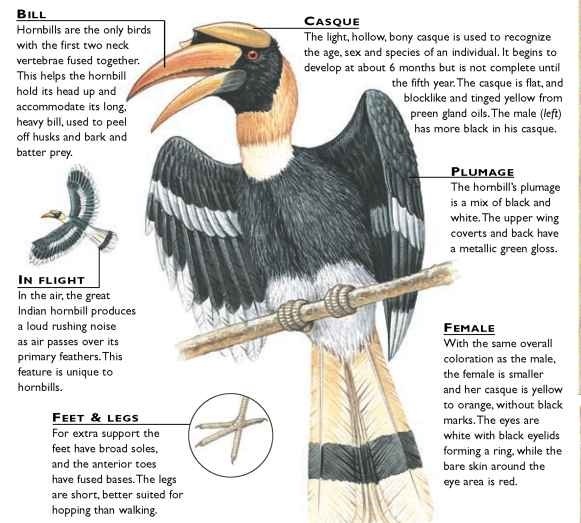
Creature comparisons
The great Philippine hornbill (Buceros hydrocorax) weighs 3.5 lbs. and measures 25.5″ in length, considerably smaller than the great Indian hornbill.The adult Philippine hornbill has a casque and similar coloring to its larger relative, and it ranges in the Philippines on the islands of Luzon and Arinduque. Like its Indian cousin, this hornbill feeds on fruit and prefers figs, but it also forages for seeds. Both birds rarely descend from their treetop habitats, and both seal their nesting entrances.

Philippine hornbill
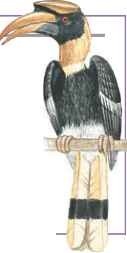
Great Indian hornbill
| VITAL | |
| STATISTICS | |
| Weight | 4.7-7.4 lbs. |
| Length | 37-41″ |
| Wingspan | Up to 63″ |
| Sexual Maturity | 4-5 years |
| Breeding Season | January-April; depends on region |
| Number of Eggs | 1-3 |
| Incubation Period | 38-40 days |
| Fledging Period | 72-96 days |
| Breeding Interval | 1 year |
| Typical Diet | Fruit, snakes, lizards, nestlings and insects |
| Lifespan | Over 41 years in captivity |
RELATED SPECIES
• The great Indian hornbill, often called the great pied hornbill, is 1 of 4 species in the genus : Buceros; the other species are the great rhinoceros hornbill, B. rhinoceros;great Philippine hornbill, : B. hydrocorax; and great helmeted hornbill, B. vigil. There are 9 genera and 54 species in the famrily Bucerotidae, which includes the northern ground hornbill, Bucorvus abyssinicus.
